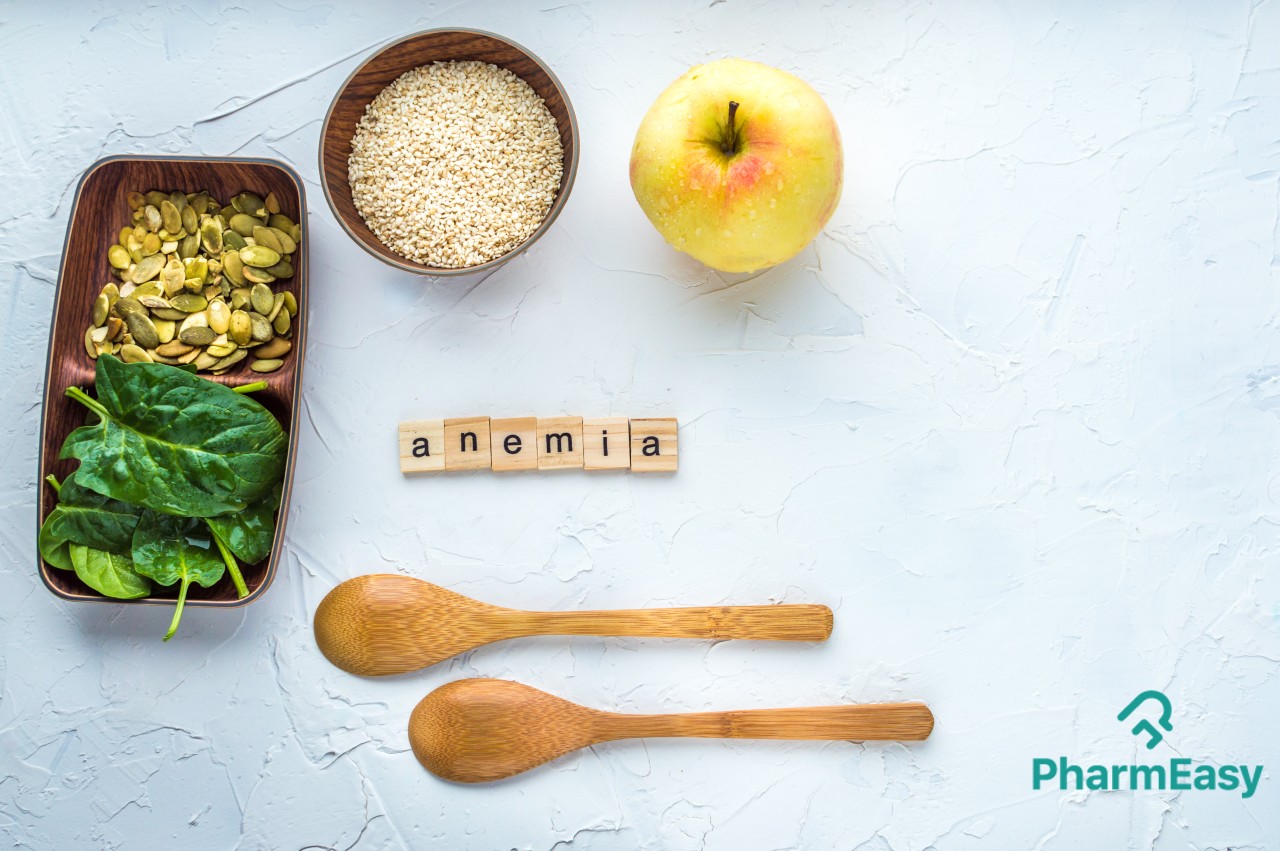The Basic Things You Should Know About Anaemia!
By PharmEasy Medical Board +2 more

Get,

to manage your symptom
Get your,


4 Cr+ families
benefitted

OTP sent to 9988776655



You’ve successfully subscribed to receive
doctor-approved tips on
Whatsapp

Get ready to feel your best.

Hi There,
Download the PharmEasy App now!!


Register to Avail the Offer
Send OTPBy continuing, you agree with our Privacy Policy and Terms and Conditions

Hi There,
Sign up on PharmEasy now!!
Trusted by 4 crore+ families

OTP sent to 9988776655



You have unlocked 25% off on medicines




Code: NU25
By PharmEasy Medical Board +2 more
Table of Contents
Anaemia is a common blood disorder in which your body does not produce enough red blood cells. Anaemia widely affects children, women, and men at any stage of life. Globally, there are over 1.6 billion people are affected by anaemia. Women and patients with chronic diseases are at a higher risk of developing anaemia.

Anaemia is a condition of lack of red blood cells that carries oxygen to all body tissues and low red blood cell count shows a low level of oxygen in your blood than normal levels. It can be mild to severe.
The severity of anaemia depends on the level of haemoglobin. Haemoglobin is a protein present in red blood cells that transport oxygen from the lungs to the other parts of the body. Haemoglobin formation requires iron, so most of the people who have anaemia have a shortage of iron.
There are various types of anaemia with their cause and treatments. Anaemia can be mild to severe as per the level of haemoglobin, but you can prevent this condition by improving your diet.
Many conditions lead to anaemia, including simple diet deficiency to major underlying causes. Common causes of anaemia are as follows –
It is one of the common forms of anaemia that often affects women than men and is more common during pregnancy. In this anaemia, your body does not have enough iron to carry oxygen through your blood to all parts of your body. Symptoms of iron-deficiency anaemia can be-
In this anaemia, your body cannot produce enough red blood cells because of damaged bone marrow.
This anaemia occurs when your body itself damages your red blood cells.
Because of the deficiency of vitamin B12, pernicious anaemia occurs.
This anaemia occurs when there are fewer numbers of red blood cells.
This is a genetic disorder that affects your red blood cells.
If you have mild anaemia, you may not have many symptoms. The sign and symptoms depend on the cause and level of haemoglobin in the body. Signs and symptoms of anaemia might include:
Anaemia treatment depends on its underlying cause. There are many treatment options based on the type and severity of anaemia.
If you are experiencing any symptoms of anaemia, a physician should be your first visit, but there are things which you can do on your own, mainly improvement in your diet. The best diet plan for anaemia includes food rich in iron and other vitamins. Here we enlisted some essential foods which can help you deal with anaemia –
Green, dark vegetables are the best source of iron. They may include –
Some of them, Swiss chard or collard greens, are also rich in folate and can be useful in folate deficiency anaemia. You can have vitamin C-rich foods such as oranges while eating these green vegetables as vitamin C may increase the absorption of iron.
Many nuts and seeds are nutritiously dense foods that contain a tremendous amount of iron. You can eat them raw or roasted as they have the same amount of iron. You can eat them as a snack or sprinkle them on a salad. Nuts and seeds may include –
Lean meat and chicken breast contain a high amount of iron, almost 22% of your recommended dose. To enhance iron absorption, pair it with vitamin C-rich vegetables such as spinach, tomatoes, and red peppers.
Seafood such as oysters is one of the best ways to supplement your diet if you are anaemic. Most of the fish contain iron, especially shellfishes such as oysters, clams, and crabs. Other types of fishes –
Beans are the most inexpensive and best source of iron for vegetarians. Some iron-rich beans are as follows –
Anaemia can be a mild to severe form of blood disorder but can be preventable. You can avoid developing anaemia by consuming nutritious food. But remember, single food will not cure anaemia; it may require an overall healthy diet like green leafy vegetables, seeds, nuts, seafood, meat, and vitamin C-rich foods.
Read more about: Top 10 Food Sources Rich in Vitamin K
Disclaimer: The information provided here is for educational/awareness purposes only and is not intended to be a substitute for medical treatment by a healthcare professional and should not be relied upon to diagnose or treat any medical condition. The reader should consult a registered medical practitioner to determine the appropriateness of the information and before consuming any medication. PharmEasy does not provide any guarantee or warranty (express or implied) regarding the accuracy, adequacy, completeness, legality, reliability or usefulness of the information; and disclaims any liability arising thereof.
Links and product recommendations in the information provided here are advertisements of third-party products available on the website. PharmEasy does not make any representation on the accuracy or suitability of such products/services. Advertisements do not influence the editorial decisions or content. The information in this blog is subject to change without notice. The authors and administrators reserve the right to modify, add, or remove content without notification. It is your responsibility to review this disclaimer regularly for any changes.

Leave your comment...
Comments